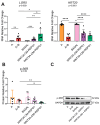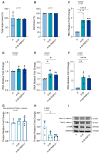Comparative Analysis of Commercial and Home-Made Media on RSPO1/S6R Axis in Organoids with Different Wnt Backgrounds: A Methodological Guide for the Selection of Intestinal Patient-Derived Organoids Culture Media
- PMID: 39519079
- PMCID: PMC11546270
- DOI: 10.3390/ijms252111526
Comparative Analysis of Commercial and Home-Made Media on RSPO1/S6R Axis in Organoids with Different Wnt Backgrounds: A Methodological Guide for the Selection of Intestinal Patient-Derived Organoids Culture Media
Abstract
WNT3A is an intestinal ligand triggering the Wnt/β-catenin (Wnt) pathway, which can be enhanced by R-spondin 1 (RSPO1) through the RSPO1-LGR axis or antagonized by the adenomatous polyposis coli (APC) protein supporting β-catenin-degradation. Wnt interplays with several pathways including PI3K/mTOR (mTOR). In this study, we evaluated the influence of WNT3A-commercial and home-made culture media and RSPO1 protein on the Wnt and mTOR interplay in non-APC and APC-mutated intestinal patient-derived organoids (PDOs). Normal mucosa (NM) of sporadic CRC and FAP PDOs were cultured with: WNT3A-lacking/containing commercial (A/A+B) or home-made (BASAL/WNT3A-conditioned medium (CM)±RSPO1) media. In non-APC-mutated-PDOs (CRC-NM), WNT3A-CM, over commercial A+B, strongly activated Wnt-target-genes CCND1 and c-MYC. Most importantly, the addition of RSPO1 to home-made WNT3A-CM or A+B led to the downregulation of the mTOR-downstream-effector phospho-S6 ribosomal protein (p-S6R), highlighting the activation of the RSPO1-pS6R in both non-APC (CRC-NM) and APC-mutated (FAP-NM) PDOs, independently from LGR5 gene expression modulation. Our work demonstrates that home-made WNT3A-CM strongly impacts the crosstalk between Wnt and mTOR over commercial media, and proposes RSPO1 as a key regulator of the RSPO1-p-S6R axis in both non-APC and APC-mutated PDOs. Together, these findings represent an important methodological guide for scientists working in these fields to select the most appropriate intestinal PDO media.
Keywords: R-spondin 1 (RSPO1); colorectal cancer (CRC); intestinal patient-derived organoid (PDO); organoids culture media; phospho-S6 ribosomal protein (p-S6R).
Conflict of interest statement
The authors declare no conflicts of interest. The funders had no role in the study design, data collection and analysis, decision to publish, or preparation of the manuscript.
Figures






Similar articles
-
Expression of R-Spondin 1 in ApcMin/+ Mice Suppresses Growth of Intestinal Adenomas by Altering Wnt and Transforming Growth Factor Beta Signaling.Gastroenterology. 2021 Jan;160(1):245-259. doi: 10.1053/j.gastro.2020.09.011. Epub 2020 Sep 14. Gastroenterology. 2021. PMID: 32941878
-
Interplay between WNT/PI3K-mTOR axis and the microbiota in APC-driven colorectal carcinogenesis: data from a pilot study and possible implications for CRC prevention.J Transl Med. 2024 Jul 5;22(1):631. doi: 10.1186/s12967-024-05305-5. J Transl Med. 2024. PMID: 38970018 Free PMC article.
-
Differential activities and mechanisms of the four R-spondins in potentiating Wnt/β-catenin signaling.J Biol Chem. 2018 Jun 22;293(25):9759-9769. doi: 10.1074/jbc.RA118.002743. Epub 2018 May 11. J Biol Chem. 2018. PMID: 29752411 Free PMC article.
-
Wnt signaling in adult intestinal stem cells and cancer.Cell Signal. 2014 Mar;26(3):570-9. doi: 10.1016/j.cellsig.2013.11.032. Epub 2013 Dec 2. Cell Signal. 2014. PMID: 24308963 Review.
-
[Familial adenomatous polyposis syndrome (FAP): pathogenesis and molecular mechanisms].Med Klin (Munich). 2003 Dec 15;98(12):776-82. doi: 10.1007/s00063-003-1325-2. Med Klin (Munich). 2003. PMID: 14685680 Review. German.
References
Publication types
MeSH terms
Substances
Grants and funding
LinkOut - more resources
Full Text Sources
Research Materials
Miscellaneous

